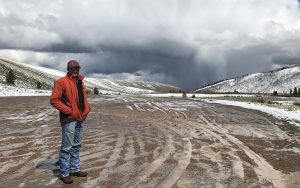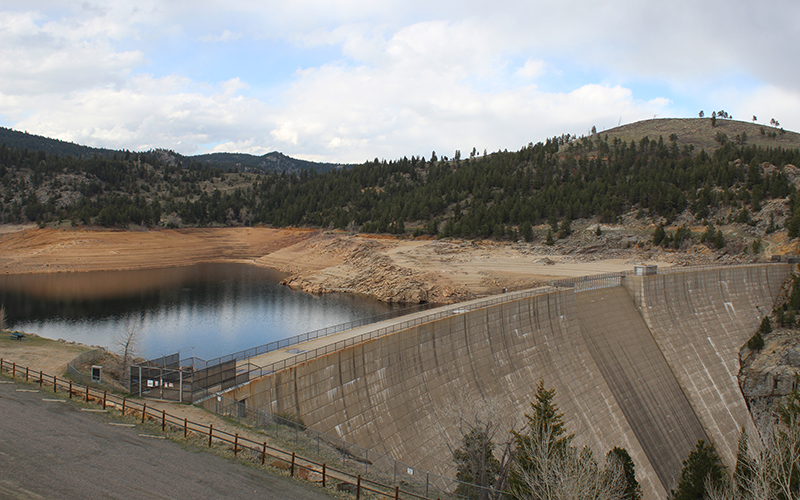
The Green River is a main tributary of the Colorado River, which supplies water to millions of people in the Southwest. (Melodie Edwards/Wyoming Public Radio)
EDITOR’S NOTE: This is Part 2 of a three-part series.
BIG PINEY, Wyo. – It’s late May in Wyoming. Snow fell the night before, and more is on the way. That’s why it’s good that rancher Chad Espenscheid is behind the wheel. The roads are sloppy and Middle Piney Creek is running high.
All this water is nerve-wracking for ranchers in western Wyoming, who depend on irrigation to feed their livestock.
“It’s been a cold, long winter,” Espenscheid said. “The cows and calves are really needing some sunshine about now. We got quite a bit of sickness going on around the (Green River) Valley.”

Rancher and Water Engineer Chad Espenscheid stands at an overlook of his property on Middle Piney Creek as a snowstorm brews behind him. (Melodie Edwards/Wyoming Public Radio)
That sickness could mean he’ll lose a lot of newborn calves.
Many aspects of ranching are stressful, and one of the big ones is water. That’s why Espenscheid is pleased the state is fixing the Middle Piney Dam, which has fallen into disrepair where the creek flows into the Green River, a major tributary of the Colorado River.
“It would give Middle Piney Creek a little more of a steady flow instead of it all coming out in one shot and everybody really having to hustle around and capture it all at one time,” he said, adding that he could use that water to irrigate his hayfields to feed those calves.
Not only is Espenscheid a rancher, he’s also a water engineer who participates in an experimental conservation program that pays ranchers to only irrigate when they have to. So in late summer, after he’s hayed his fields, he turns off the spigot. But fixing Middle Piney Dam will store a modest 4,200 acre-feet of water that would have wound up in the Colorado, Espenscheid said.
He’s not sure what to think about how that will affect Lower Basin states that also rely on the Colorado River.
“I don’t know, I’m just Wyoming through and true, so I’m kind of worried about Wyoming, I guess, to be honest,” Espenscheid said. “So I think we’ve got to take care of our own sustainability and make sure we have opportunities for growth.”
It’s not just the Middle Piney Reservoir that’s being expanded, though. Jason Mead with Wyoming’s Water Development Office adds up the acre-feet of water storage the state wants to build on the Green River watershed.
“Four thousand for Middle Piney, 10,000 for West Fork; that’s 14,000,” Mead said. “Another 8 (thousand) at New Fork, so that’s 22,000, another 9 (thousand) between Meek’s Cabin, that’s 31,000.”
All told, he figures Wyoming could add about 50,000 acre-feet with five new or expanded reservoirs, including Big Sandy, West Fork, Meek’s Cabin and Stateline. And then there are the 80,000 acre-feet that the Fontanelle Reservoir on the Green River eventually could add, once drought lowers the water level enough to finish the foundation.
At 130,000 acre-feet total, that would be enough water to supply a city of a million people – but Wyoming’s entire population is half that.
“Every one of these projects we’re talking about,” Mead said, “really are for irrigation shortages and trying to handle the drought situations that everybody has faced over the years and trying to take water when we have good years and carry it over into years that are drier,” Mead said.
And those drier years are expected to worsen. Long-range forecasts predict heavy snowpacks will melt and flood earlier and earlier, leaving ranchers with less water in the summer.
“If we can’t keep those businesses afloat, eventually they’re going to have to sell,” Mead said. “Do they get developed in the future? We don’t know, but if we keep them in ranching, we know we’re going to maintain that open space.”
Although more dams could help ranchers survive coming droughts, some scientists say building more dams, particularly those meant to control flooding, might actually worsen climate change.
“They want the water drained out so in the event of a flood they have storage capacity,” University of Wyoming soil scientist Jay Norton said. “That can cause very low flows downstream that dry up those floodplain wetlands,” which store huge amounts of organic carbon.
“There’s estimates that if we could raise soil organic carbon by about 0.4 percent per year, that we would completely offset human-derived emissions of greenhouse gases,” Norton said.
Think of all the plants along streams in the otherwise arid Mountain West. Wetlands on undammed waterways can cover as little as 2% of the landscape but hold 15% to 30% of the carbon. But if reservoirs hold all the water, those riparian areas will dry up and lose the ability to hold carbon.
According to Norton, however, more dams in the Upper Basin – if managed correctly – could create more wetlands and store more carbon.
“Conceivably, it could have a positive effect on downstream wetlands, if water tables are maintained relatively high,” he said. “Irrigation itself expands wetlands.”
Unfortunately, that’s not the only effect dams have on climate. One study shows that decomposing organic matter behind dams as water levels drop can produce large amounts of methane, a greenhouse gas that’s even more potent than carbon dioxide.
But Espenscheid, the rancher and water engineer, said the positives of building dams outweigh the negatives.
“Most ranchers, they’re ranchers because they love their ranch and they love the outdoors and they love the wildlife and everything about it,” he said. “So if you can find a win-win solution, then everybody’s happy.”
The question is: With all the Upper Basin states investing in more dams, what will the cumulative effect be?
This story is part of “The Final Straw,” a series produced by the Colorado River Reporting Project at KUNC, KUER and Wyoming Public Radio.
This story is part of Elemental: Covering Sustainability, a new multimedia collaboration between Cronkite News, Arizona PBS, KJZZ, KPCC, Rocky Mountain PBS and PBS SoCal.
AlertMe
